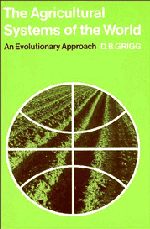Book contents
- Frontmatter
- Contents
- Acknowledgements
- 1 Introduction
- PART ONE
- PART TWO
- 5 Shifting agriculture
- 6 Wet-rice cultivation in Asia
- 7 Pastoral nomadism
- 8 Mediterranean agriculture
- 9 Mixed farming in western Europe and North America
- 10 Dairying
- 11 Plantations
- 12 Ranching
- 13 Large-scale grain production
- 14 Conclusions
- Appendix: Regions of plant domestication
- Notes
- Bibliography
- Index
9 - Mixed farming in western Europe and North America
Published online by Cambridge University Press: 10 March 2010
- Frontmatter
- Contents
- Acknowledgements
- 1 Introduction
- PART ONE
- PART TWO
- 5 Shifting agriculture
- 6 Wet-rice cultivation in Asia
- 7 Pastoral nomadism
- 8 Mediterranean agriculture
- 9 Mixed farming in western Europe and North America
- 10 Dairying
- 11 Plantations
- 12 Ranching
- 13 Large-scale grain production
- 14 Conclusions
- Appendix: Regions of plant domestication
- Notes
- Bibliography
- Index
Summary
Europe north of the Alps in Roman times was thinly populated, and, compared with the Mediterranean region, possessed of a backward agricultural technology. But, as has been seen in the preceding chapter, economic ascendancy had passed from south to north by the seventeenth century, not only in trade and industry but also in agriculture. Northern Europe is the home of two of the most productive of agricultural systems, mixed farming and dairying.
Mixed farming – or Commercial Crops and Livestock, as it was described by Whittlesey – is found throughout Europe, from Ireland in the west through central Europe into Russia. It is also found in North America east of the ninetyeighth meridian, reaching its apogee in the Corn Belt: outliers are to be found in other areas of European settlement, in the Argentine pampas, South East Australia, South Africa and New Zealand (Fig. 1). The origins of mixed farming in Australia and Argentina are different from those in Europe, and are more conveniently dealt with in Chapter 12. In Europe Whittlesey made a threefold division; he assigned the British Isles (save the east), Scandinavia, and the coastal regions of France, Germany and the Low Countries to a dairying belt; western and central Europe he assigned to Commercial Crops and Livestock; and eastern Europe, the Balkans and European Russia north of the steppe to a subsistence sub-category of Crops and Livestock.
- Type
- Chapter
- Information
- The Agricultural Systems of the WorldAn Evolutionary Approach, pp. 152 - 186Publisher: Cambridge University PressPrint publication year: 1974



